This chapter gives an overview of various inexpensive meters and tests available today, what they measure, and how to use the information they provide to help make medical cannabis gardens more efficient and productive. Meters allow gardeners to measure specific elements so each can be incrementally improved. Meters also help you find the weakest point in the chain of growth.
Meters and test kits measure air, water, growing mediums, electricity, light, sound, and more. They can be analog, digital, or reagent test kits. Digital and analog meters perform hundreds of tests; reagent kit tests are limited to consumables, which must be replaced.
Meter housing should be durable and waterproof, and meters should be easily calibrated (if necessary) or self-calibrating, although some more sensitive meters with a sealed housing must be periodically returned to the factory for calibration. Other important features include: automatic temperature compensation (ATC), temperature readings in degrees Fahrenheit (ºF) or degrees Celsius (ºC), backlit liquid crystal display (LCD), microprocessor, memory, replaceable electrode, a broad range of accurate measurement, accuracy (+/-) listing, the ability to interface with computers or cell phones, and availability in handheld/portable or wall- or counter-mounted units with battery and instructions included. Some meters are available with remote probes at an additional cost. Some meters may have several components and wireless communication capabilities. Also note that some meters are subject to contamination and aging.
| GARDEN METERS | BASIC* | ADVANCED* |
| anemometer | $50 | $200 |
| hygrometer | $20 | $20 |
| thermometer | $10 | $30 |
| smoke detector | $20 | $20 |
| carbon dioxide (CO2) sensor | $200 | $800 |
| carbon monoxide (CO) detector | $20 | $50 |
| decibel (sound) meter | $50 | |
| ELECTRIC AND LIGHT METERS | BASIC* | ADVANCED* |
| electric circuit tester 3-prong plug | $5 | $20 |
| electricity monitor | $30 | |
| light meter | $40 | $100 |
| volt/amp meter | $30 | |
| SOIL, NUTRIENT-SOLUTION, AND WATER METERS | BASIC* | ADVANCED* |
| ppm meter—CF (conductivity factor), EC (electrical conductivity factor) | $50 | $20 |
| moisture meter | $20 | $20 |
| pH meter | $20 | $50 |
| TDS (total dissolved solids) meter | $50 | |
| ERGS (energy released per gram of soil) meter | $80 | |
| compost thermometer | $20 | |
| ORP (oxygen reduction potential) meter | $100 | |
| sodium (Na) meter | $80 | |
| water pressure gauge | $10 | |
| N-P-K test (reagent) kits | $20 | $20 |
| MISCELLANEOUS METERS | BASIC* | ADVANCED* |
| refractometer | $80 | |
| digital refractometer | $180 | |
| distance | $30 | |
| microscope (handheld) | $40 | $40 |
| ultraviolet light | $50 | $200 |
| Total | $265 | $1,075 |
*Approximate prices in USD
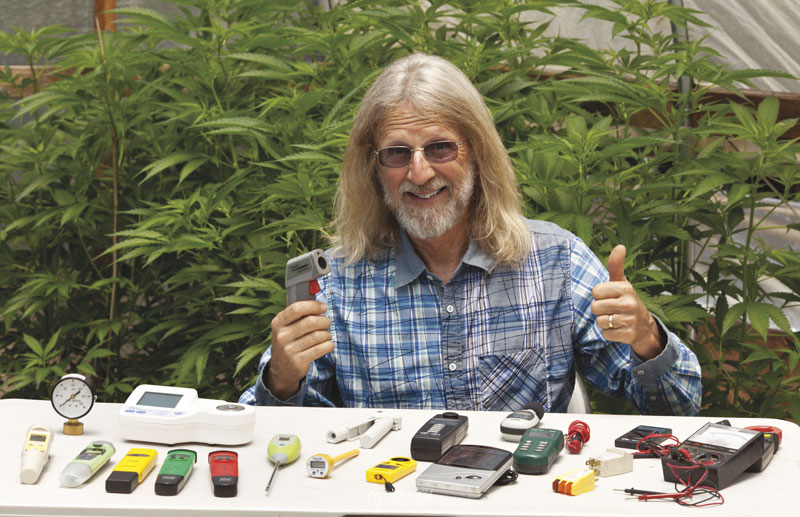
A relatively small investment in accurate meters will provide you with correct information to make informed gardening decisions.
A few meters are essential—electrical circuit testers, thermometers, and hygrometers top the list. These meters will allow you to measure air temperature and humidity (moisture) content. Thermometers can also measure the temperatures of soils and nutrient solutions. The next most essential meters include pH and electrical conductivity (EC) meters, which measure parts per million (ppm) and total dissolved solids (TDS). More expensive models of these meters will take measurements perpetually and store a record that can be uploaded to a computer, mobile telephone, or Internet site. (It is easy to set up a security camera and monitor it with an iPhone, iPad, Android telephone, or computer. The data can then be analyzed and acted upon. However, many medical cannabis gardeners prefer not to send such delicate information by telephone.)
The Garden Meters table shows recommended meters for “Basic” and “Advanced” gardens. Use this information only as a guideline. The prices are approximate and may vary from country to country. Prices were current as of summer 2014.
To see more than 1,800 scientific videos on how to master any meter that you could possibly imagine, type “MIT Digital Lab Techniques Manual” into a web browser. Click on the YouTube link to go to the Massachusetts Institute of Technology’s videos.
You can also type “video digital (name/ type of) meter” into Google and see numerous videos on how to calibrate and use specific meters.
It can be difficult to find all the meters you want at one store. I had to go to the auto parts store to buy a digital laser thermometer, for example, rather than a gardening center. Find, research and order any meter you need by typing in “buy (name of meter)” into a web browser.
Air Meters
Anemometers measure air or wind speed. They are common weather station instruments. There are two classes of anemometers; one measures wind speed and the other measures wind pressure, both of which are related. Anemometers designed for one will give information about both. Handheld meters work well to measure wind outdoors in microclimates.
I use my anemometer to measure wind around my outdoor garden. Indoors, I use it to measure air speed when setting up ventilation and circulation fans. Move it around the garden and see just how bad airflow is in between plants! See chapter 16, Air, for more information about airflow.
Electrochemical carbon dioxide (CO2) sensorsmeasure electrical conductivity of an air sample in either an alkali solution or distilled/deionized water. These systems are relatively inexpensive, but they have drawbacks: limited accuracy and sensitivity to temperature and air pollutants.
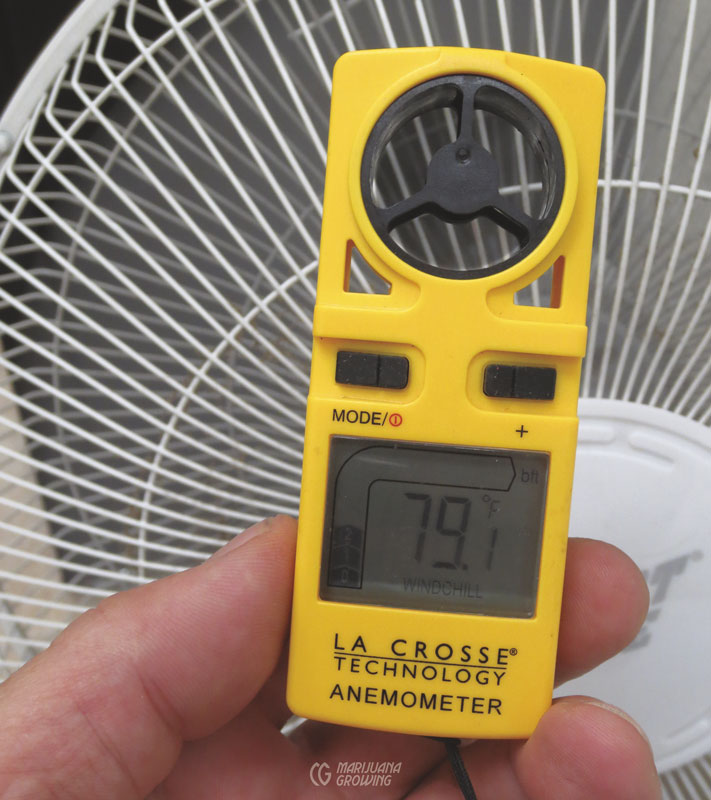
Anemometer
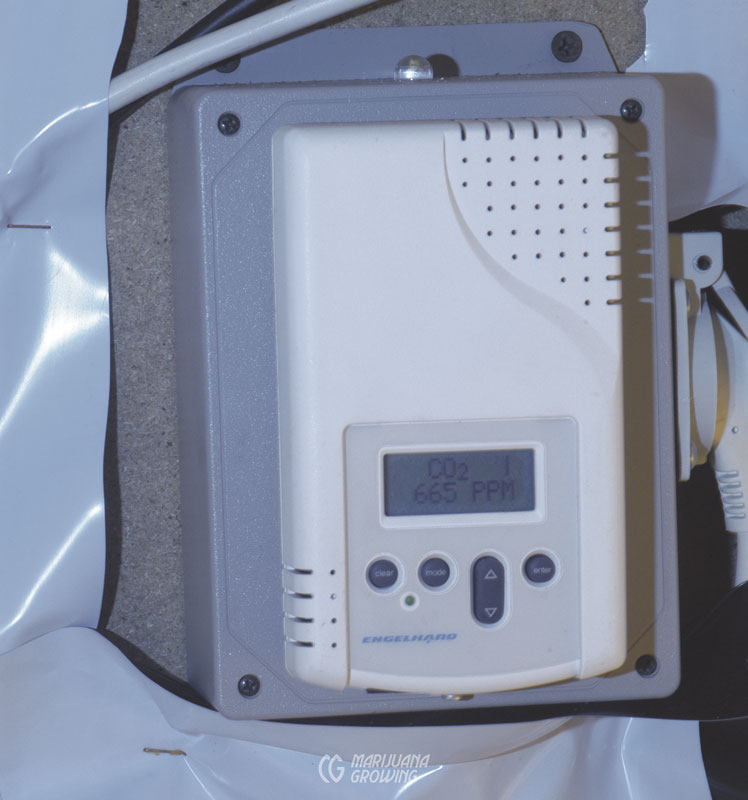
CO2 sensor
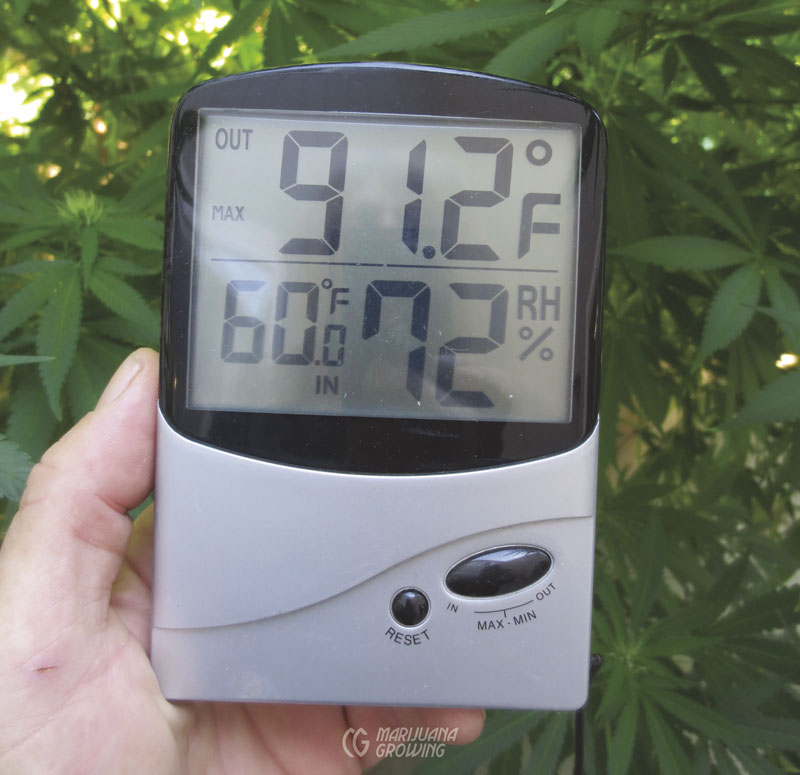
Thermometer
Most CO2 sensors or meters are nondispersive infrared (gas) sensors (NDIR) and chemical gas sensors. These sensors are used in the air conditioning, horticulture, building, and safety industries to monitor air quality and CO2 levels. NDIR sensors measure infrared radiation emitted from a heated surface. Most devices can measure from 0 to 5,000 ppm CO2. Set up sensors in the garden room or in air ducts. CO2 sensor/controllers will turn compressed CO2 and generators on and off at desired levels. More sophisticated CO2 controllers can be synchronized with controllers that operate heat, ventilation, and CO2 generators. Shop around to find sensors that are battery or AC-powered and wall mounted with remote probes.
Disposable comparative colorimetric CO2 test kits are fairly easy to use and inexpensive. CO2 detector tubes are used to make spot tests. The tubes contain a chemical enclosed in a glass tube with a break-off tip. The tube is placed in a small hand pump (syringe), the tip is broken off, and a sample of air is drawn into the tube. The tube color length or intensity indicates the approximate intensity of CO2. They test from a trace to about 7 percent (7,000 ppm). Colorimetric kits are reliable to within about 40 ppm. Tubes cost about $5 USD each and make one test.
Hygrometers measure relative humidity (RH)—moisture content in the air at a given temperature. Most hygrometers convert measurements of temperature, pressure, mass, or an electrical or mechanical change in a material as it absorbs moisture. Humidity is difficult to measure accurately. Hygrometers are available in three basic types: metal/ pulp coil, hair tension, and electronic. I cannot recommend metal/pulp coil types because their accuracy is limited. Hair tension hygrometers use human or animal hair under tension that changes length as humidity changes. Hair tension hygrometers are more accurate, but still not as accurate as electronic versions.
Electronic chilled mirror dew point hygrometers give precise measurements—as accurate as ± 0.5 percent RH when clean and calibrated.
Capacitive humidity sensors are pretty accurate (± 2%) and are little affected by condensation and high temperatures over short periods.
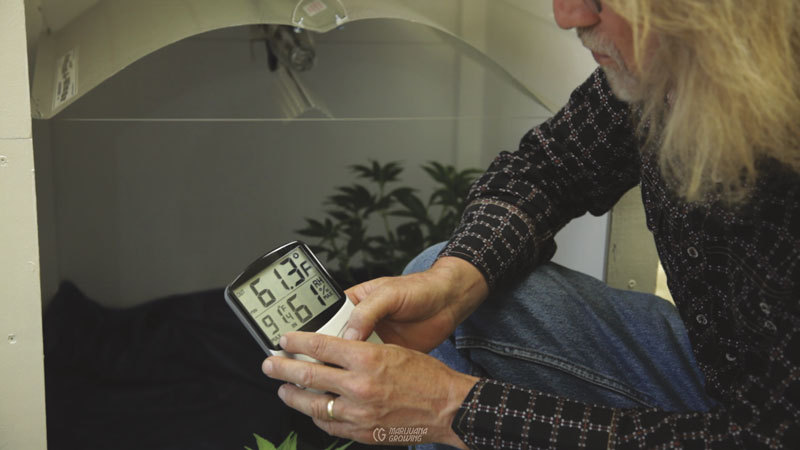
Hygrometer
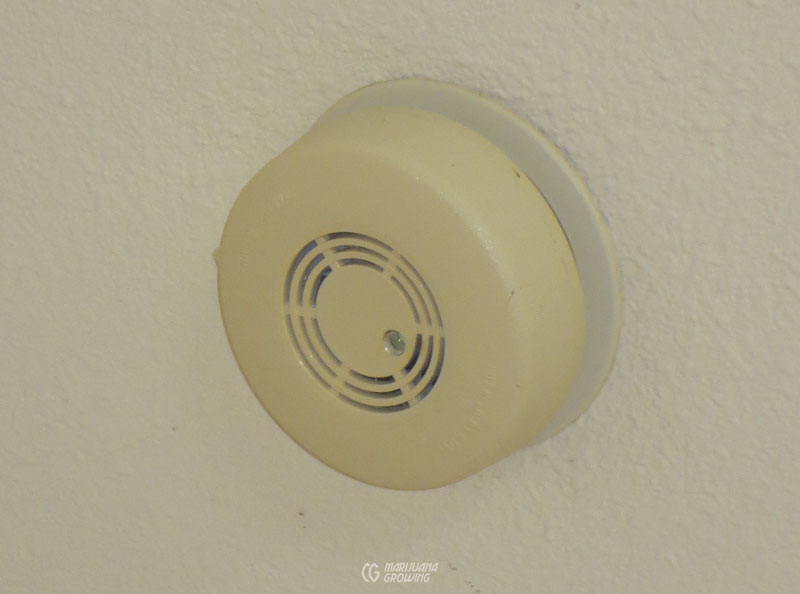
Smoke detector
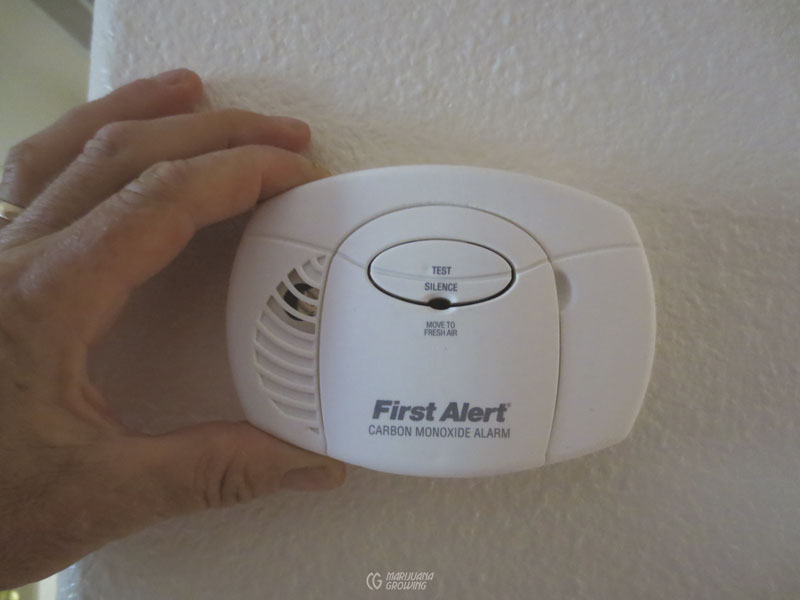
Carbon monoxide (CO) detector
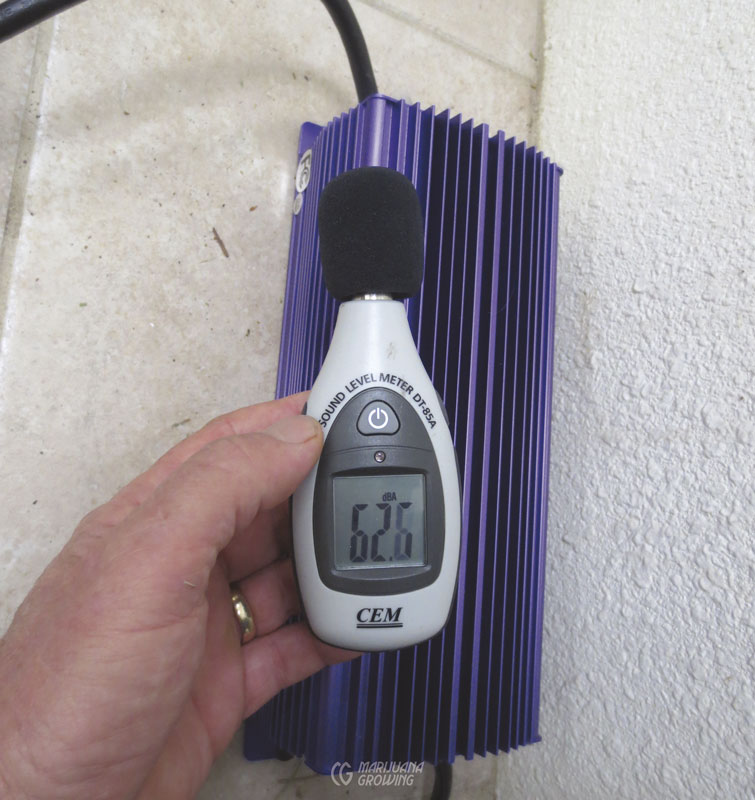
Decibel (sound) meter
| LIGHT MEASUREMENT SCALES | |
| fc | foot-candles |
| Lux | lux |
| LM | lumens |
| PAR | photosynthetic active radiation |
| PPFD | photosynthetic photon flux density |
| K | Kelvin temperature |
| μmol m²·sec | micromol per square meter per second |
| μE·m²·sec | microeinsteins per square meter per second |
| 2,000 μmol·m²·sec | intense sunlight |
| W/m²/nm | watts per square meter per nanometer |
| W/cm² | watts per square centimeter |
Resistive humidity sensors measure electrical resistance relative to humidity. Meters with capacitive sensors are more sensitive than those with resistive sensors. Resistive humidity sensors usually have an accuracy rating of ± 3 percent.
Thermal conductivity humidity sensors measure absolute humidity.
A humidistat is a hygrometer with a control feature. See chapter 16, Air, for more information.
A psychrometer also measures relative humidity. It has 2 bulbs: 1 dry and 1 wet. Water on the wet bulb evaporates and the temperature of each bulb is measured. The difference between temperatures is logged and correlated on a chart to find the relative humidity. A psychrometer can also be used to measure dew point and make basic weather predictions.
Thermometers measure temperature. Many people prefer old reliable liquid-and-glass thermometers with a Fahrenheit scale on one side and a Celsius scale on the other. Inexpensive spring-type thermometers are not accurate enough for medical cannabis gardeners. I prefer digital thermometers that record both indoor and outdoor temperatures. They also have a maximum and minimum readout that can be reset. More expensive thermometers record daily data and store it for downloading to a computer.
Digital laser thermometers are a lot of fun and incredibly informative to use. The thermometer projects a laser beam and records the temperature at the end of the beam. I use mine to measure leaf and stem surface temperatures, and those of water, soil, and walls—any temperature, really. See “Temperature” in chapter 16, Air, for more information about temperature differentials and what they mean.
Accurate temperature readings come in very handy when solving culture issues or pest and problems. Always take temperature readings at different points in the room. For more information, see “Temperature” in chapters 16, Air; 18, Soil; and 20, Water.
A thermostat measures temperature and perpetually controls heating and cooling devices such as heaters, fans, and air conditioners.
Smoke detectors detect smoke. And where there is smoke, there is usually fire. Some detectors are connected to a fire alarm. Inexpensive and readily available battery-powered smoke detectors should be placed at high points in garden rooms, where smoke will collect. Most of these devices detect smoke by optical detection (photoelectric) or by ionization. More expensive models use both detection methods.
Automatic fire extinguishers come with a built-in smoke detector.
Mount handheld fire extinguishers by exit and entrance doors so you will know where they are when a room you are in fills with smoke.
Carbon monoxide (CO) detectors identify the presence of deadly CO gas, to prevent carbon monoxide poisoning. A product of incomplete combustion, colorless odorless CO, the “silent killer,” is virtually undetectable without a CO detector. Elevated levels of CO are dangerous to humans, and low concentrations can be harmful over time. Use a CO detector to guard against high levels of CO if using a kerosene or fossil fuel CO3 generator or internal combustion motor.
Note: It can take up to a year for CO to release from the blood. CO accumulates over time!
Decibel (sound) meters measure sound pressure level with an LED (light-emitting diode) screen readout in decibels (dB). Most meters are relatively accurate. Look for a meter with high (65 to 130 dB) and low (35 to 100 dB) measuring ranges—great for measuring noise from fans, analog ballast, pumps, and so forth. I was most amazed when I went into the backyard at night with still, quiet air that carries sound. The slightest “click” or muffled exhaust fan echoes! The 4-inch (10 cm) vent fan registers 50 dB at 10 feet away from the outlet. Ambient noise levels register 20 dB when the fan is off.
Electric and Light Meters
An electric circuit tester 3-prong plug shows circuit status for an individual outlet. I like the 3-light color-coded display that shows ground, neutral, and hot circuits. More-advanced plugs have a GFI (ground fault interrupt) trip button. These testers are essential for electrical safety and for solving simple electrical problems. Keep the circuit tester in your tool kit. Check all electrical circuits periodically to prevent problems before they start!
Electricity monitors measure electricity use. Inexpensive monitors plug into electrical outlets and monitor the electrical use of specific appliances. More expensive models monitor electrical use history that can be uploaded to a computer. Sophisticated meters are wireless and can monitor electricity use in the entire household or garden. There are many different brands and levels of technology. Learn more by searching “electricity monitor” using your search engine or Amazon.com.
Light meters measure light intensity and spectrum. Inexpensive to moderately priced meters measure light in foot-candles, lux, and lumens. These scales measure light that is visible to humans—400 to 700 nm (nanometers). But not all light is created equal.
Plants do not use the entire light spectrum equally, and light sources do not generate spectrums equally. While our eyes may see only the blending of the light frequencies, plants are looking for specific wavelengths to trigger responses in the various photosystems. PAR (photosynthetically active radiation) light is the spectrum fingerprint plants need to see, and anything else, while we may see it as very bright, the plant does not see or use. Matching lamp spectrum to the PAR requirements of the plant is important. Having a measuring device that effectively does this for the grower is a luxury.
You can use a light meter that measures foot-candles, lux, or lumens to measure the intensity of sunlight, HP sodium, metal halide, CFL, and fluorescent light. Sunlight is generally perfect for cannabis growth, and there is little we can do to change it. Light intensity meters that measure foot-candles, lux, and lumens are accurate when measuring the intensity of lamps with known PAR ratings. Indoors, always use lamps with the highest PAR rating. For more information, see “PAR Light” in chapter 17, Light, Lamps & Electricity.
PAR or quantum light meters often claim to accurately measure the photons or light particles that plants need to grow. Check the technical data closely on meters before making a purchase. Meters often measure lux and then convert to PAR. High-quality sophisticated quantum meters can switch to measure “sunlight” or “electric lamps.” Quantum light meters display a specific numeric PAR value in the LED screen. A PAR meter is not necessary to measure natural sunlight. Search “Electric and Light Meters” at www.marijuanagrowing.com for more information about measuring PAR light.
Volt/amp meters: This essential device tells you how many volts and amperes are flowing in an electrical line at any point and time. This meter helps you troubleshoot line amperage and voltage excesses and deficiencies. Use this meter to probe electrical outlets for deficiencies and measure voltage and ampere line drop when running electrical wires for more than 10 feet.
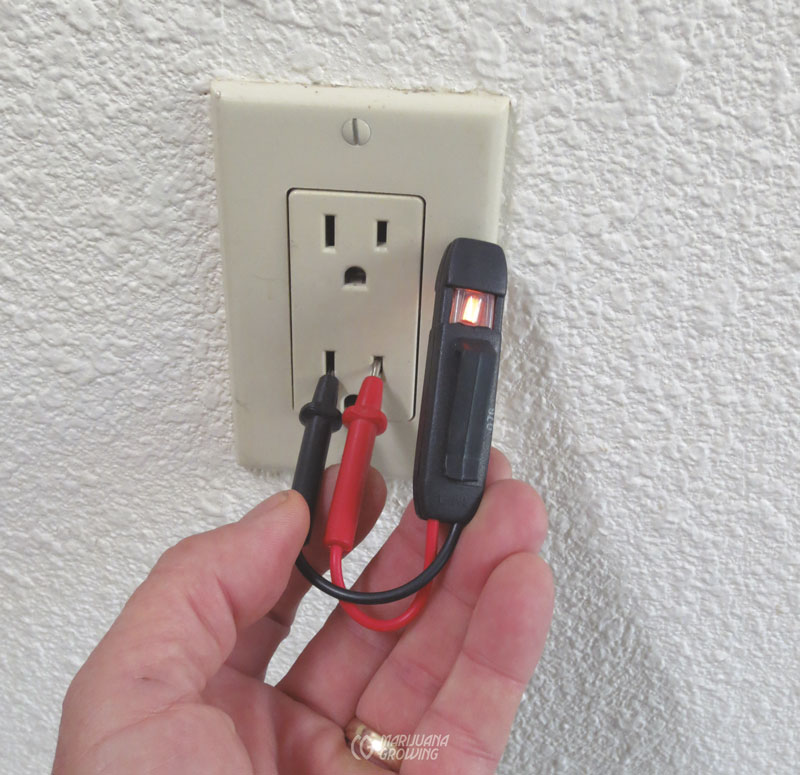
Electric circuit tester 3-prong plug
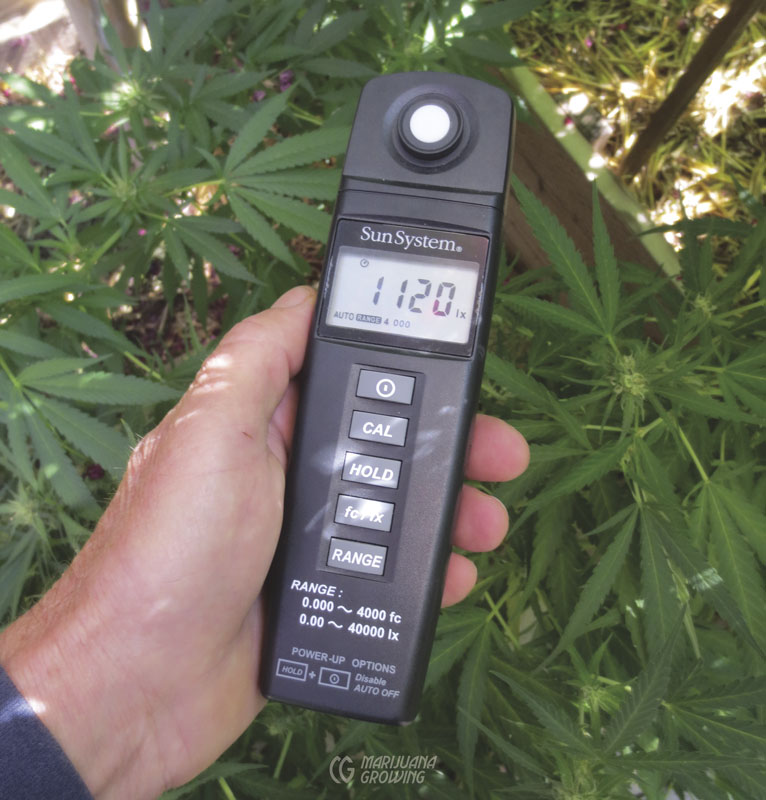
Light meter
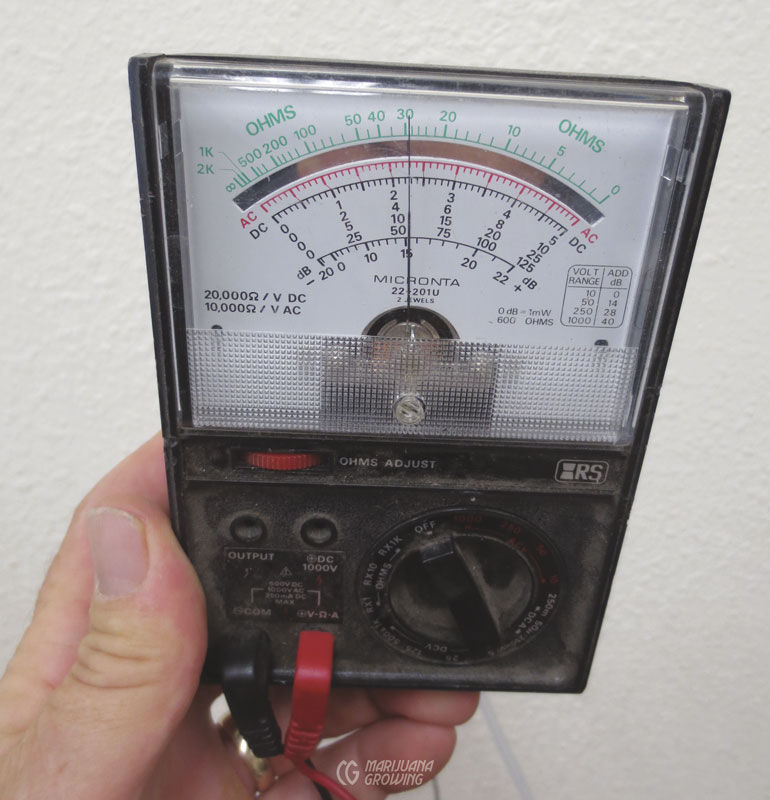
Volt/amp meter
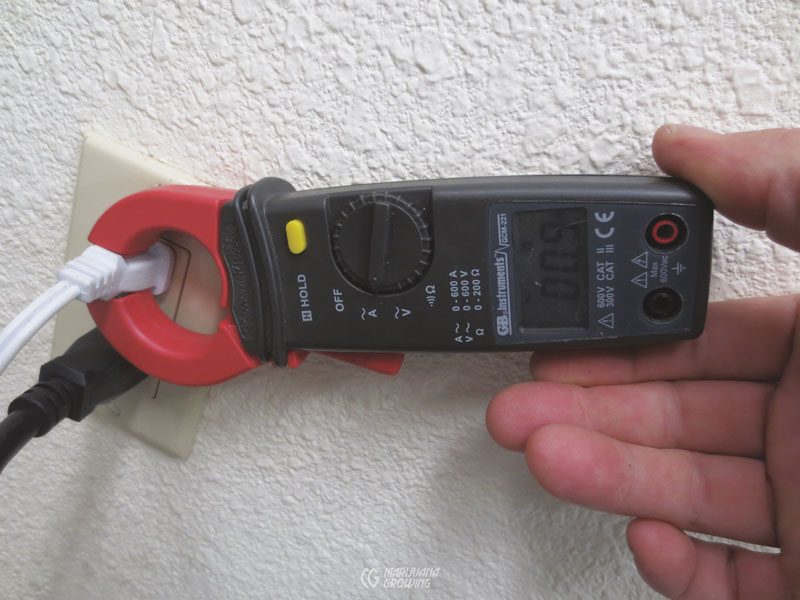
Electricity monitor
Soil, Nutrient-Solution, and Water Meters
pH meters measure the potential hydrogen (pH) in a substance or solution. Measurement and control of pH are essential to healthy medical cannabis gardens.
Digital meters measure electrical current between two probes and are designed to work in water and moist soil. The growing medium must be moist for an accurate reading. Digital electronic meters can make thousands of measurements with little or no additional cost per test.
Electronic pH meters are economical and convenient. Less expensive pH meters lack automatic temperature compensation but are accurate enough for casual use. Intermediately priced digital pH meters contain a glass bulb electrode that must be kept clean and moist at all times. Proper maintenance ensures accurate readings. Digital pH meters—when properly maintained and calibrated— can accurately perform hundreds of tests. More expensive models are quite accurate when properly calibrated.
These meters must be regularly calibrated to ensure their accuracy. The inexpensive probe meters are not very accurate, and the intermediately priced meters also have accuracy issues. The pH sensor must be replaced at required intervals based on age and usage.
Insert the probe(s) into the nutrient solution or soil, and the pH value will appear on a small LCD screen. Pay special attention to soil moisture when taking a pH test with an electronic meter. The meters measure the electrical current between two probes and are designed to work in moist soil. If the soil is dry, the probes do not give an accurate reading. I prefer electronic pH meters to reagent test kits and litmus paper because these meters are convenient, economical, and accurate. Once purchased, you can measure pH thousands of times with an electronic meter, while the chemical test kits are good for about a dozen tests. Perpetual pH-metering devices are also available and are most often used to monitor hydroponic nutrient solutions.
More-expensive models contain a glass bulb electrode that must be kept clean and moist at all times. Failure to maintain the tester properly could lead to inaccurate readings. An automatic temperature compensation (ATC) feature makes meters much more convenient and accurate. Keep litmus paper or a liquid dye reagent kit as a backup in case the meter malfunctions.
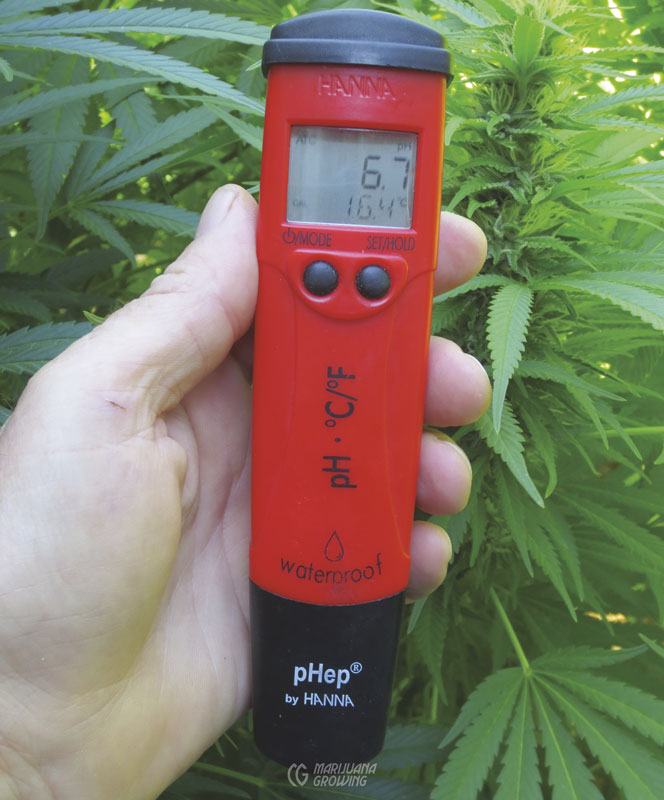
Medium-priced pH meters must be regularly calibrated and the sensor properly maintained.
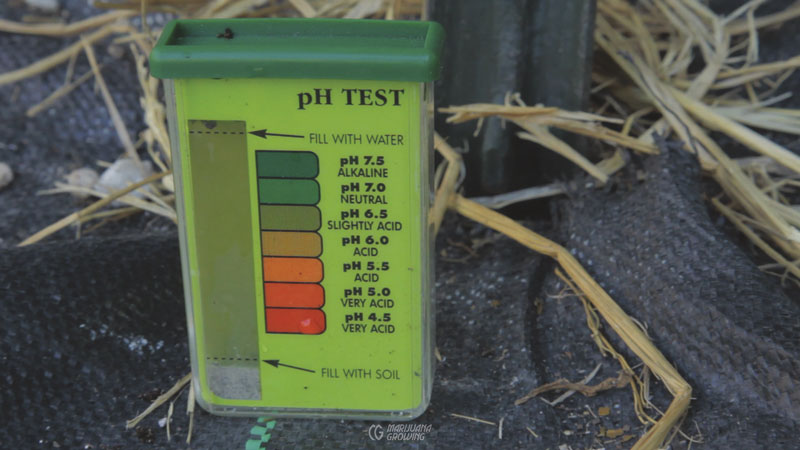
A pH test kit measurement can be somewhat difficult to read but accurate nonetheless.
The pH level can also be measured with a liquid reagent kit that is similar to the N-P-K test kits discussed in this chapter. Liquid pH reagent test kits work by adding a drop or drops of pH-sensitive dye to the nutrient solution. Mix by shaking, and compare the color of the treated nutrient solution to a color chart. Such tests are a little difficult to read but quite accurate.
Do not measure pH with phenolphthalein and phenol red (aka phenolsulfonphthalein or PSP) test kits. They are frequently used in cell biology laboratories but can distinguish only between a pH of 6.8 and 8.2.
Nutrient (Ionic Salt) Meters
EC = electrical conductivity
ppm = parts per million
CF = conductivity factor
TDS = total dissolved solids
Different measurement systems all use the same base, but they interpret the information differently. Let’s start with electrical conductivity (EC), the most accurate and consistent scale. EC is measured in millisiemens per centimeter (mS/cm) or microsiemens per centimeter (μS/cm). One millisiemen per centimeter = 1,000 microsiemens per centimeter.* EC is the most accurate measure of total ionic salts in solution. An EC meter measures the overall volume or strength of elements (ionic salts) in water or solution.
*millimhos and micromhos are other units of measurement often used for plant recommendations. 1 millisiemens = 1 millimhos = 1,000 microsiemens = 1,000 millimhos
Parts per million (ppm) meters actually measure in EC and convert to ppm. Unfortunately, the two scales (EC and ppm) are not directly related. Each nutrient or salt gives a different electronic discharge reading. To overcome this obstacle, an arbitrary standard assumes that “a specific EC equates to a specific amount of nutrient solution.” Consequently, the ppm reading is only an approximation. Also, manufacturers of nutrient testers use different standards to convert from EC to the ppm reading.
Every salt in a multielement solution has a different conductivity factor (CF). Pure water will not conduct electrical current, but when elemental salts/metals are added, electrical conductivity increases proportionately. Simple electronic meters measure this value and interpret it as total dissolved solids (TDS). Nutrient solutions used to grow cannabis generally range between 500 and 2,000 ppm. If the solution concentration is too high, the internal osmotic systems can reverse and actually dehydrate the plant. In general, try to maintain a moderate value of approximately 800 to 1,200 ppm. The EC should stay below a high of 2.7.
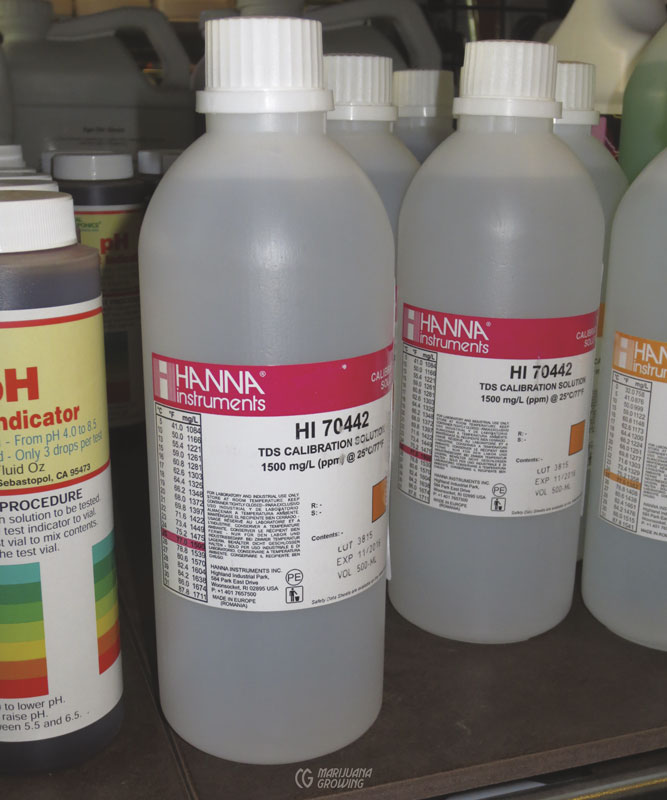
This TDS calibration solution is rated at 1,500 mg/L.
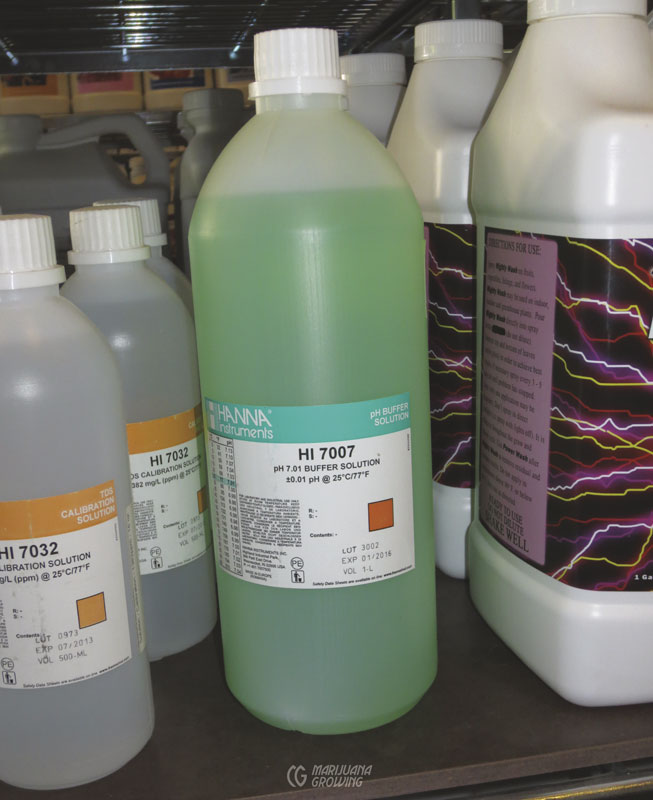
The pH 7.0 buffer solution is color-coded.
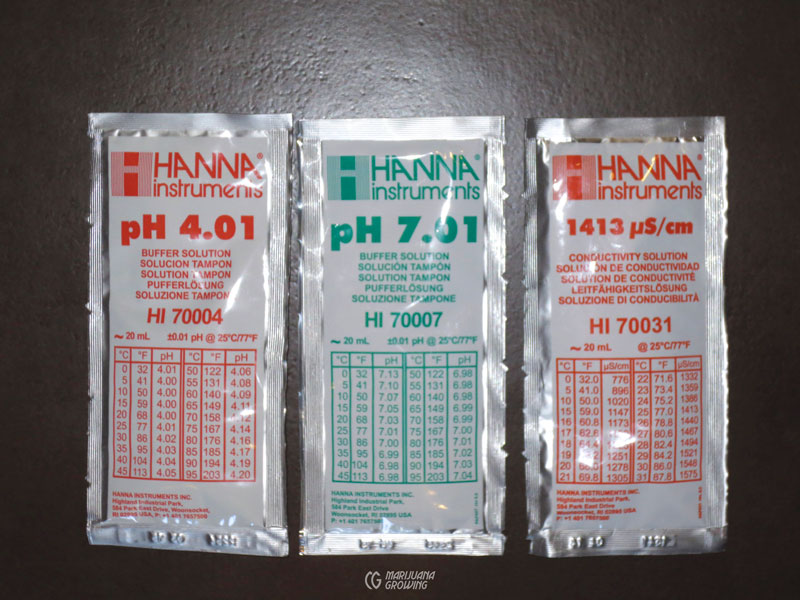
Calibration solution is available in packets.
Electrical conductivity (EC) meters measure the overall volume or strength of elements in water or solution. A digital LCD screen displays a reading of electrical current flowing between the two electrodes. Pure rainwater has an EC close to zero. Check the pH and EC of rainwater to find out if it is acidic (acid rain) before using it.
Distilled bottled water from the grocery store often registers a small amount of electrical resistance, because it is not perfectly pure. Pure water with no resistance is very difficult to obtain and is not necessary for a hydroponic nutrient solution. Electrical conductivity measurement is temperature-sensitive and must be factored into EC readings to retain accuracy. High-quality meters have automatic and manual temperature adjustments. Calibrating an EC meter is similar to calibrating a pH meter. Simply follow manufacturer’s instructions. For an accurate reading, make sure your nutrient solution and stock solution are at the same temperature.
Inexpensive meters last for about a year; expensive meters can last for many years. However, the life of most EC meters, regardless of cost, is contingent upon regular maintenance. The meter’s probes must be kept moist and clean at all times. This is the most important part of keeping the meter in good repair. Read instructions on care and maintenance. Watch for corrosion buildup on the probes of your meter. When the probes are corroded, readings will not be accurate.
Digital dissolved salt meters are used to measure the overall strength of a nutrient solution. Nutrient (ionic salt) concentrations are measured by their ability to conduct electricity through a solution. Several scales are currently used to measure how much electricity is conducted by the concentration of ionic salts (nutrients) between two electrodes. A digital LCD screen displays the reading in one of the following scales: CF, DS, EC, ppm or TDS, which all measure the same thing: dissolved ionic (fertilizer) salts. Each meter has a different scale but more sophisticated meters are able to make readouts in several scales including CF, EC, ppm, and TDS.
Most North American gardeners use the ppm scale to measure overall fertilizer concentration. European, Australian, and New Zealand gardeners use EC, however they still use CF in parts of Australia and New Zealand. Parts per million is not as accurate or consistent as EC to measure nutrient solution strength.
The difference between CF, EC, ppm, TDS, and DS is more complex than originally meets the eye. Different measurement systems all use the same base, millisiemens per centimeter, but they interpret the information differently.
A dissolved solids (DS) measurement indicates how many parts per million of dissolved solids exist in a solution. A reading of 1,800 ppm means there are 1,800 parts of nutrient in one million parts of solution, or 1,800/1,000,000.
Make sure to calibrate your meter before using it.
A total dissolved solids (TDS) meter measures solution EC and uses an approximate conversion scale to convert to ppm. The conversion is not very accurate because solutions that are composed of different elements will have different ppm values. One conversion figure becomes exceedingly inaccurate. The most accurate measure is osmotic concentration (or EC) because this is what the root systems respond to in a nutrient solution.
Parts per million meters measure the overall level of dissolved solids or fertilizer salts. Each fertilizer salt conducts different quantities of electricity. Use a calibrating solution that imitates the fertilizer in the nutrient solution to calibrate ppm or EC meters. Using such a solution ensures that the meter readings will be as accurate as possible. For example, 90 percent of ammonium nitrate dissolved in water is measured, and a mere 40 percent of magnesium is measured! Do not use sodium-based calibration solutions. They are intended for other applications than gardening. Purchase calibrating solution from the manufacturer or retailer when you buy the meter. Ask for a stable calibrating solution that mimics your fertilizer.
Calibrate EC and ppm meters regularly. A good combination ppm-EC-pH meter that compensates for temperature costs about $200 USD and is well worth the money. Its batteries last a long time, too.
Inexpensive digital dissolved salt meters last for about a year. Expensive meters can last for many years. However, the life of most EC meters, regardless of cost, is contingent upon regular maintenance. The probes must be kept moist and clean at all times, which is essential to keep the meter in good repair. Read instructions on care and maintenance. Watch for corrosion buildup on the probes, and keep them clean. When the probes are corroded, readings will not be accurate.
Check the scale each manufacturer uses to measure mS/cm with their meter. Here are the values that three major manufacturers assign:
Hanna: 1 mS/cm = 500 ppm
Eutech: 1 mS/cm = 640 ppm
New Zealand Hydro: 1 mS/cm = 700 ppm

Digital DS meters measure dissolved solids (salts) by their capacity to conduct electricity through a solution.
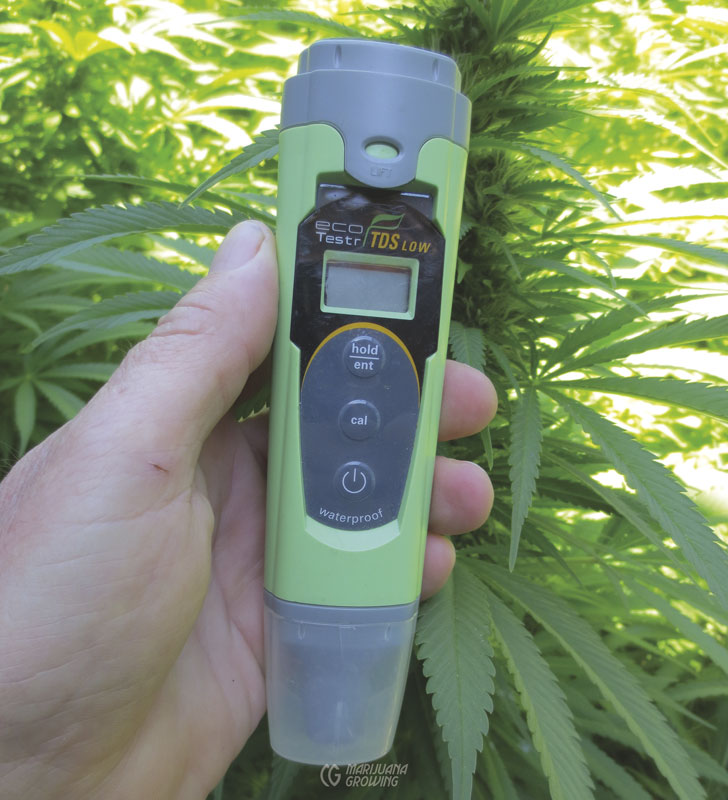
Total dissolved solids meter
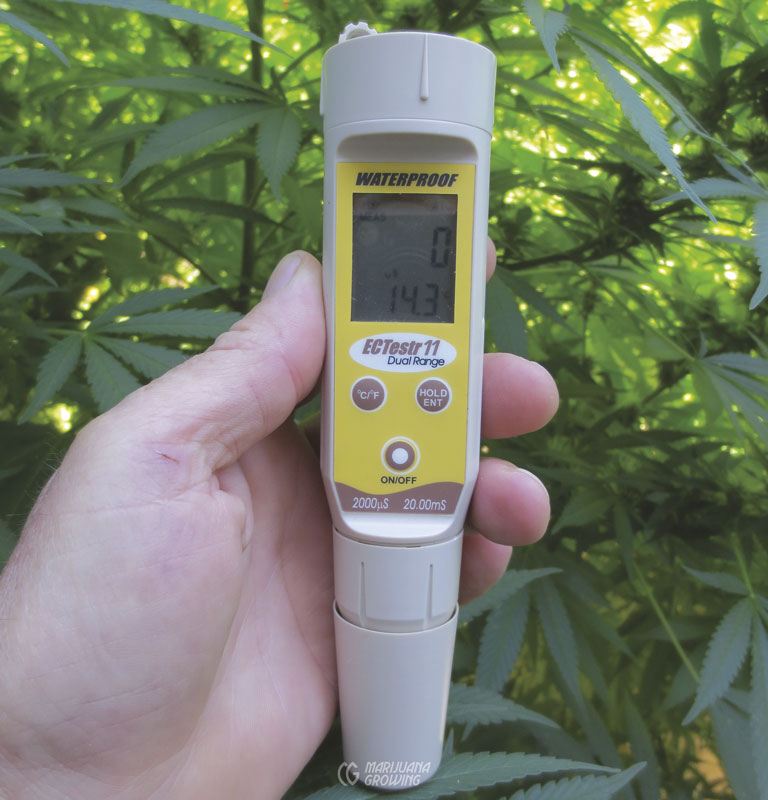
Electrical conductivity (EC) meter
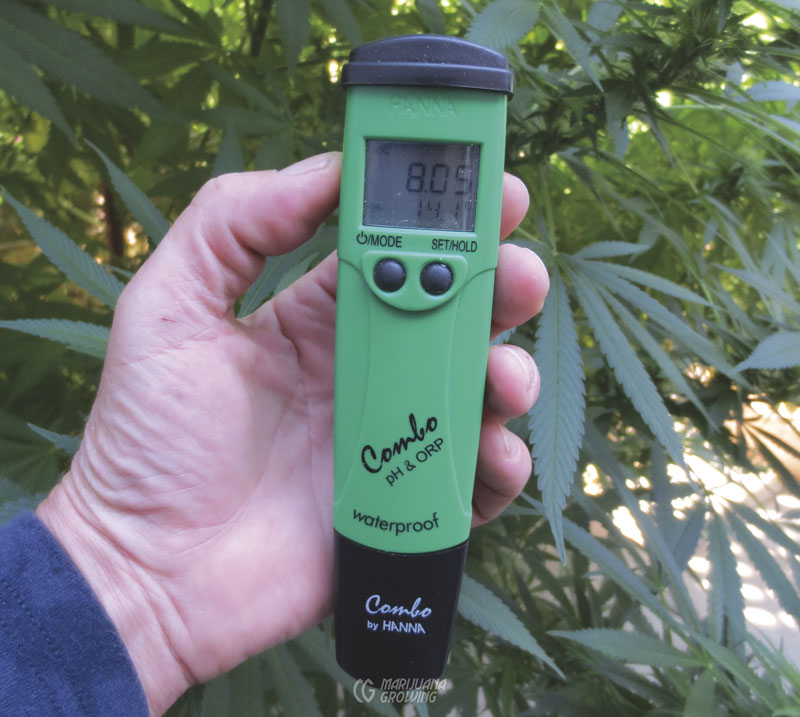
ORP (oxygen reduction potential) meter
Moisture meters measure moisture levels in soil and growing mediums and should be used as a backup device to common sense. They work under the same concept as EC—with an electrical charge—and temperature, EC, and pH will all affect the reading, as will improper or nonstandardized placement, meter calibration, and media composition. Even the pros do not use these as anything other than to see trends.
Use moisture meters outdoors to test overall moisture content around plants. Dry spots are easy to find. Note how the moisture level increases deeper in the soil, especially outdoors. Outdoors, the top few inches of soil often dry out, while deeper soil is completely moist. Nonetheless, watering only the top few inches leads to problems; all irrigations should be deep.
Compost thermometers have a 2- to 3-foot-long probe to stick deep into compost piles so you can measure heat in the center. The gauge ranges from 50°F to 220°F (10°C–104.4°C) because compost piles heat up tremendously while breaking down organic matter.
Use a compost thermometer to check the level of activity in your compost. Make sure all compost has cooled to 90°F (32.2°C) before using it in the garden.
Testing at different depths will give you an idea of the biological activity that occurs at different temperatures. Once compost experiences the digestive system of bacteria, fungi, microbes, and other soil live, the entire aspect changes. See “Compost” in chapter 18, Soil, for more information.
ERGS (energy released per gram of soil) meters measure the available nutrient level in ERGS, mobile ions of fertility. For cannabis, the soil’s conductivity (mobile ion reading) should be between 50 and 500 ERGS. Higher ERGS levels mean optimum production. This meter can also test fertilizers, soil amendments, and compost to help determine the most effective fertilization strategies.
ORP (oxygen reduction potential) meters measure oxygen reduction potential or potential available oxygen in soil and foliar sprays. Oxygen reduction potential is measured in volts or millivolts. Available oxygen is essential to roots’ ability to uptake nutrients.
You can measure available oxygen and combine the ORP and pH readings to get an rH value, a more precise measure of available oxygen. Low oxygen levels indicate limited biological activity and less humus-building. Too much oxygen oxidizes organic materials and loses carbon to the atmosphere. More oxygen in foliar fertilizer and pest control sprays increases plants’ absorption ability.
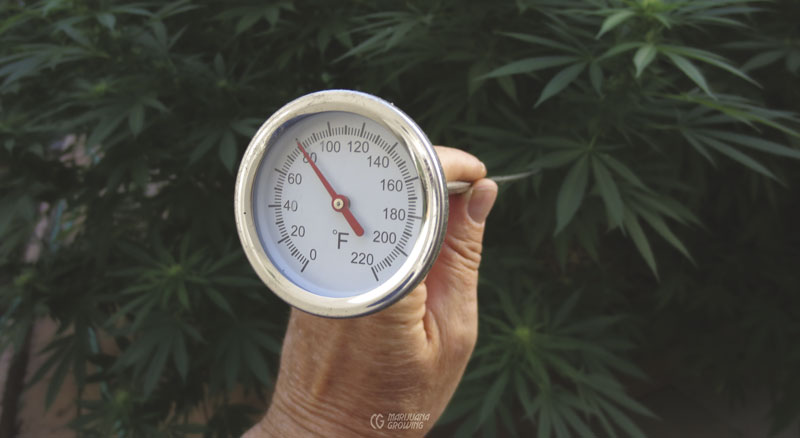
Compost thermometer
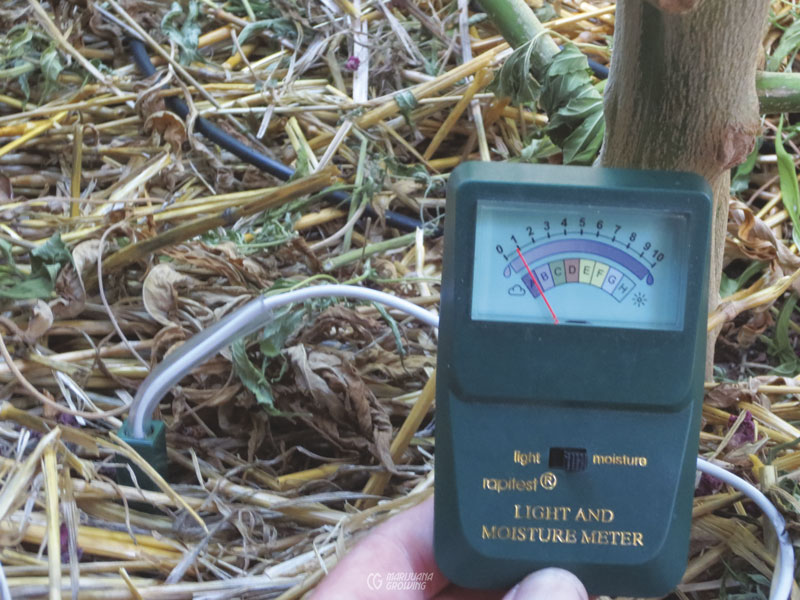
Inexpensive moisture meters are handy, and, when used properly, they take the guesswork out of watering.
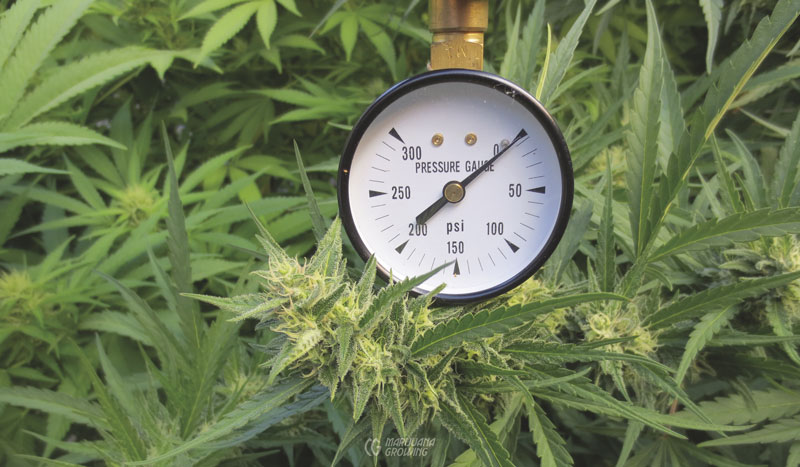
Water pressure gauge
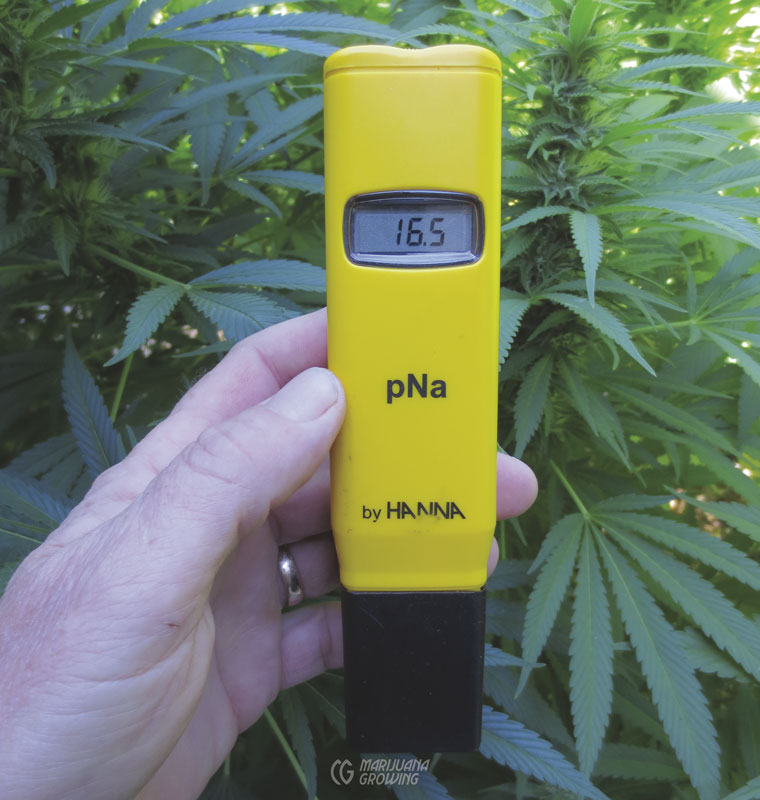
Sodium (Na) meter
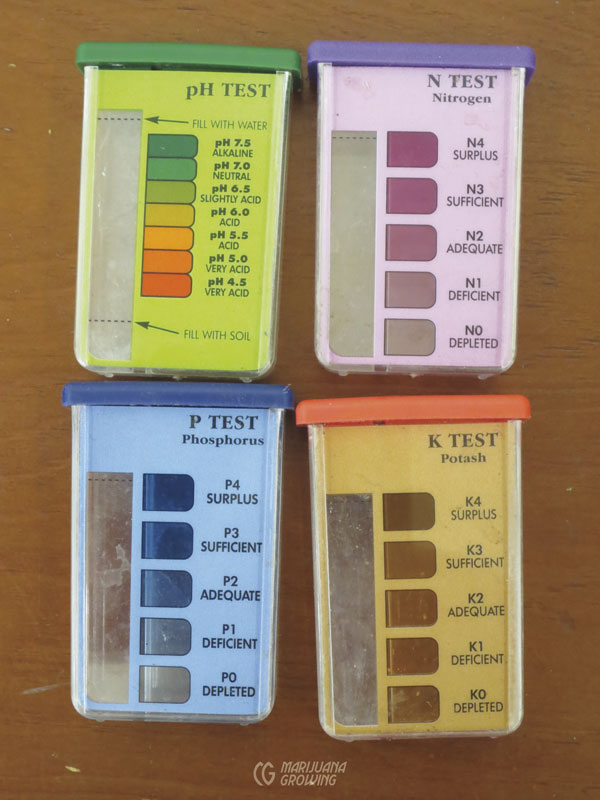
N-P-K test (reagent) kits
Handheld electronic dissolved oxygen (DO) meters measure dissolved oxygen in solution. Inexpensive aquarium test kits are also available but less accurate. DO meters record temperature and give oxygen levels in percentage of solution saturation. The nutrient solution in the reservoir should be a minimum of 5 ppm (5 mg/L) dissolved oxygen (DO) at 50°F (10°C), 6 ppm (6 mg/L) at 65°F (18.3°C). Very cold fresh water will hold up to 14 ppm (14 mg/L) of dissolved oxygen. Aer-ating the nutrient solution can inject 5 to 8 ppm (5–8 mg/L) oxygen into the water and hold it for about 24 hours.
Handheld electronic dissolved oxygen (DO) meters measure dissolved oxygen in solution. Inexpensive aquarium test kits are also available but less accurate. DO meters record temperature and give oxygen levels in percentage of solution saturation. The nutrient solution in the reservoir should be a minimum of 5 ppm (5 mg/L) dissolved oxygen (DO) at 50°F (10°C), 6 ppm (6 mg/L) at 65°F (18.3°C). Very cold fresh water will hold up to 14 ppm (14 mg/L) of dissolved oxygen. Aer-ating the nutrient solution can inject 5 to 8 ppm (5–8 mg/L) oxygen into the water and hold it for about 24 hours.
Sodium (Na) meters measure sodium levels in growing medium, compost, and organic fertilizer. Use in conjunction with an ERGS meter. High levels of sodium reduce fertilizer effectiveness and become toxic to microorganisms. If the ERGS reading is high due to high sodium levels, corrective action will be necessary to prevent harm to soil microbes, humus formation, and, ultimately, plant growth.
Manure often contains salt that is given to livestock along with feed. If manure is not fully leached and composted, the salt remains. Incompletely composted manures and other materials that contain toxic levels of salt are often ingredients in both bulk and bagged soil. Always test new bulk soil, compost, and manure for high sodium levels before purchasing and using.
Water pressure gauges test pressure at the water source and along the water line. Most gauges fit into the water line and read out in pressure on a dial. A pressure gauge is inexpensive and especially handy to check irrigation pressure for a pump outlet or on a hillside.
N-P-K test (reagent) kits will give you a basic idea of soil fertility for a few pennies per test. A small bit of soil and water are mixed with a reagent. The soil solution is agitated and left to settle. The liquid turns color and is then compared with the color on a chart. An exact reading of nutrients is difficult to achieve.
Miscellaneous Meters
Refractometers (aka Brix meters) measure sugar content (Brix) in cannabis leaves and stems. High Brix readings indicate adequate nutrition and fertilizer absorption. Cannabis with Brix above 12 has a healthy immune system. Use clean pliers to squeeze sap from leaves onto the refractometer’s glass plate, and then turn it toward the sun to read the Brix count in the viewer. Most meters are very accurate and measure from 0 to 30 Brix.
A Digital refractometer measures sugar content (Brix) of cannabis foliage. Measurements are simple and quick after calibration with deionized or distilled water. This meter measures the refractive index of the sample and converts it to percentage of Brix concentration. I like this meter because it eliminates the uncertainty associated with mechanical refractometers.
Laser tape measures are a high-tech alternative to a mechanical tape measure. These little meters are very useful in the garden. I use mine all the time to measure garden rooms and outdoor garden areas, even distance between plants. I can stand in the same place and calculate complete garden room dimensions in seconds. Just point it at a large flat object and get distance readings in feet or meters. Press two more buttons to figure square and cubic feet, both of which are very handy when setting up a garden room and calculating space.
Microscopes—30X to 50X—can be handheld, desktop, and with or without a computer interface. I like the small handheld 45X LED light microscope. It fits in my pocket, the light is bright, the battery is long-lasting, and it is easy to keep clean. Another favorite is the 30X fold-open microscope originally used by stamp collectors. This scope is perfect to take a close look at resin glands but is not so powerful that depth of field is limited. More powerful desktop microscopes provide a closer view but are difficult to focus on all resin glands. Computer interface microscopes are relatively inexpensive and show close-up shots of resin but often lack definition.
Ultraviolet lights expose body fluids, molds, and insect excrement. Use a UVB flashlight to detect insect droppings and trails, fungus spores, and damage. UV light has been used in the hotel industry and by law enforcement for many years to detect body fluids and other residues that are not easily visible to the naked eye. Ultraviolet rays that are transmitted across a surface show a chemical signature. More sophisticated devices available to law enforcement are able to read the signature.
Spot the bad bugs and the despicable destruction in their wake. Use the UVB flashlight to snoop around the garden room, greenhouse, and outdoor garden at night. UVB light makes slug and snail slime trails glisten and both bug exudates and bud excrement glow. It also makes powdery mildew spores take on iridescent hues and tones.
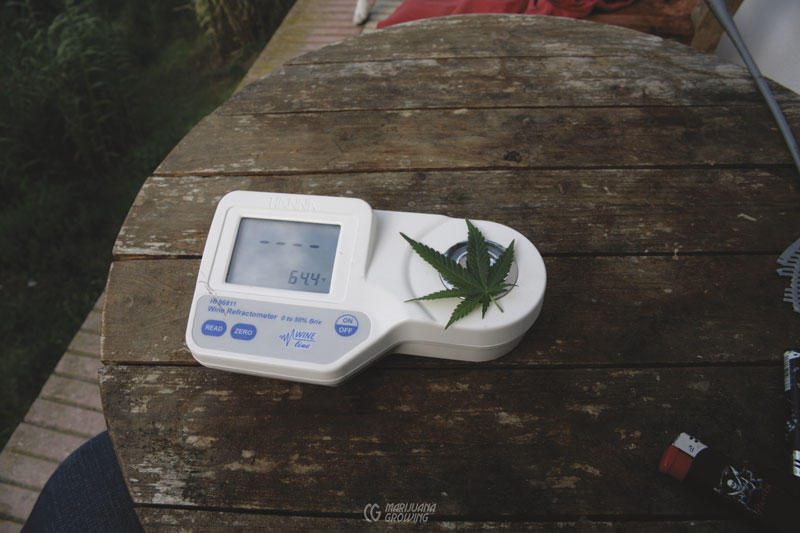
Digital refractometers make measuring sugar content in foliage easy and very precise.
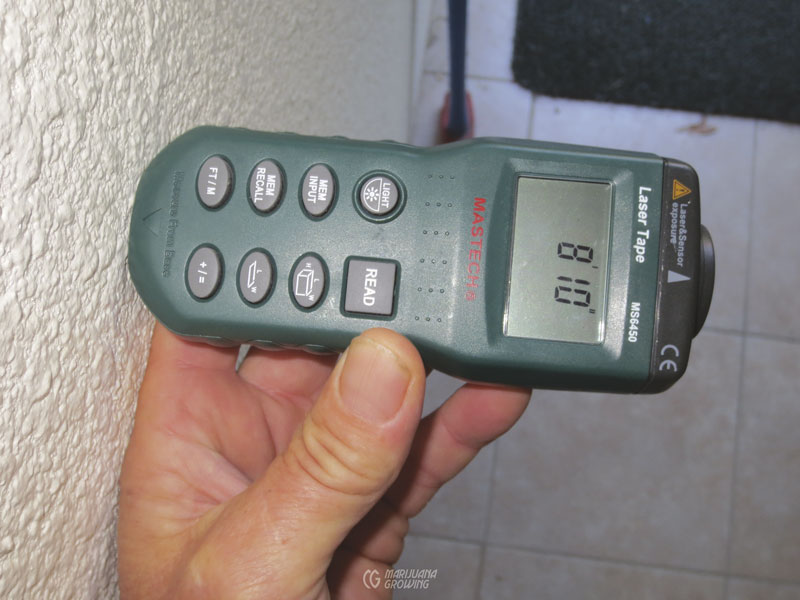
A digital laser tape measure adds precision to garden room construction.

Ultraviolet (UVC) light is deadly to many diseases and pests when briefly exposed.
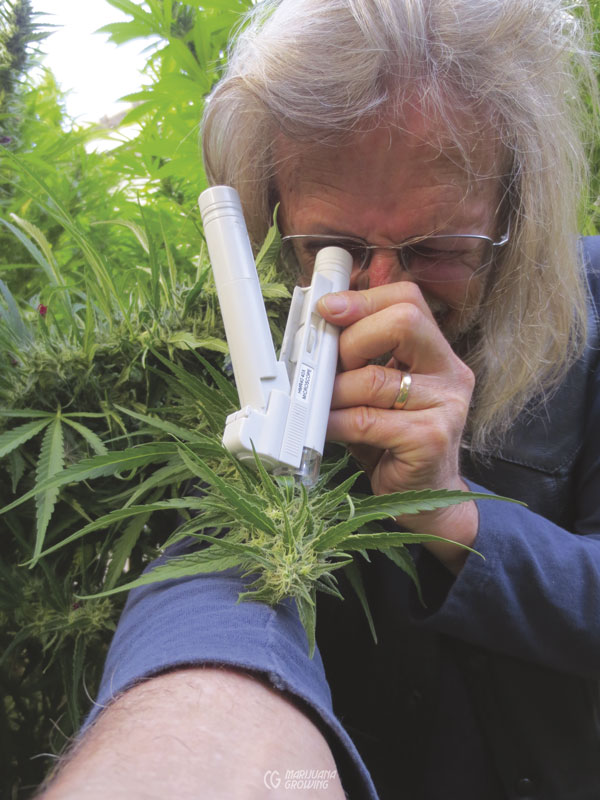
A handheld microscope simplifies garden research.

